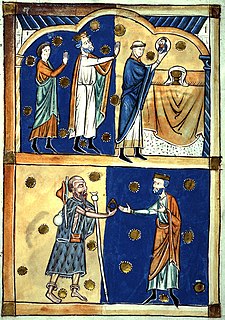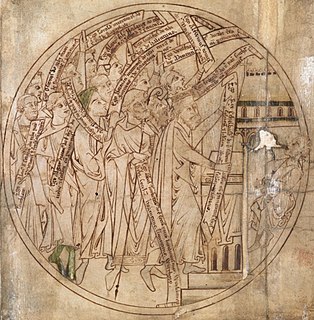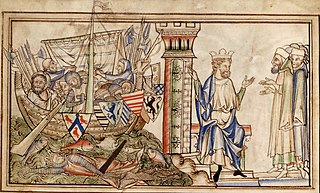Related Research Articles

Harold Godwinson, often called Harold II, was the last crowned Anglo-Saxon king of England. Harold reigned from 6 January 1066 until his death at the Battle of Hastings, fighting the Norman invaders led by William the Conqueror during the Norman conquest of England. His death marked the end of Anglo-Saxon rule over England.
Godwin of Wessex became one of the most powerful earls in England under the Danish king Cnut the Great and his successors. Cnut made Godwin the first Earl of Wessex. Godwin was the father of King Harold Godwinson and of Edith of Wessex, who in 1045 married King Edward the Confessor.

Edward the Confessor was among the last Anglo-Saxon kings of England. Usually considered the last king of the House of Wessex, he ruled from 1042 to 1066.

Harold I, also known as Harold Harefoot, was King of England from 1035 to 1040. Harold's nickname "Harefoot" is first recorded as "Harefoh" or "Harefah" in the twelfth century in the history of Ely Abbey, and according to some late medieval chroniclers it meant that he was "fleet of foot".
Gruffydd ap Llywelyn was king of Wales from 1055 to 1063, he united the whole of Wales in 1057. He was the son of King Llywelyn ap Seisyll and Angharad, daughter of Maredudd ab Owain. He was the great-great-grandson of Hywel Dda. Gruffydd ap Llywelyn is considered to be the first and last king of Wales.

Ealdorman was a term in Anglo-Saxon England which originally applied to a man of high status, including some of royal birth, whose authority was independent of the king. It evolved in meaning and in the eighth century was sometimes applied to the former kings of territories which had submitted to great powers such as Mercia. In Wessex in the second half of the ninth century it meant the leaders of individual shires appointed by the king. By the tenth century ealdormen had become the local representatives of the West Saxon king of England. Ealdormen would lead in battle, preside over courts and levy taxation. Ealdormanries were the most prestigious royal appointments, the possession of noble families and semi-independent rulers. Their territories became large, often covering former kingdoms such as Mercia or East Anglia. Southern ealdormen often attended court, reflecting increasing centralisation of the kingdom, but the loyalty of northern ealdormen was more uncertain. In the eleventh century the term eorl, today's earl, replaced that of ealdorman, but this reflected a change in terminology under Danish influence rather than a change in function.

Earl of Wessex is a title that has been created three times in British history, twice in the pre-Conquest Anglo-Saxon nobility of England and once in the Peerage of the United Kingdom. The region of Wessex, in the south and southwest of England, had been one of the Anglo-Saxon kingdoms, whose expansion in the tenth century created a united Kingdom of England.
Gytha Thorkelsdóttir, also called Githa, was a Danish noblewoman. She was the mother of King Harold Godwinson and of Edith of Wessex, queen consort of King Edward the Confessor of England.

Leofric was an Earl of Mercia. He founded monasteries at Coventry and Much Wenlock. Leofric is most remembered as the husband of Lady Godiva.
Leofwine was appointed Ealdorman of the Hwicce by King Æthelred II of England in 994. The territory of the Hwicce was a kingdom in the Western Midlands in the early Anglo-Saxon period, which soon became a subdivision of Mercia. Leofwine was the son of Ælfwine, who is otherwise unknown, but the family appears to have originated in the East Midlands. Leofwine and his sons were considered by the See of Worcester as spoliators who seized church land, but East Midlands religious establishments regarded them as benefactors.

Eadric Streona was Ealdorman of Mercia from 1007 until he was killed by King Cnut. Eadric was given the epithet "Streona" in Hemming's Cartulary because he appropriated church land and funds for himself. Eadric became infamous in the Middle Ages because of his traitorous actions during the Danish re-conquest of England.

Siward or Sigurd was an important earl of 11th-century northern England. The Old Norse nickname Digri and its Latin translation Grossus are given to him by near-contemporary texts. Siward was probably of Scandinavian origin, perhaps a relative of Earl Ulf, and emerged as a powerful regional strongman in England during the reign of Cnut. Cnut was a Scandinavian ruler who conquered England in the 1010s, and Siward was one of the many Scandinavians who came to England in the aftermath of that conquest. Siward subsequently rose to become sub-ruler of most of northern England. From 1033 at the latest Siward was in control of southern Northumbria, that is, present-day Yorkshire, governing as earl on Cnut's behalf.

Ælfgar was the son of Leofric, Earl of Mercia, by his famous mother Godgifu. He succeeded to his father's title and responsibilities on the latter's death in 1057. He gained the additional title of Earl of East Anglia, but also was exiled for a time. Through the first marriage of his daughter he would become father-in-law of the Welsh king Gruffydd ap Llywelyn; a few years after his death, his daughter would become a widow and marry English King Harold.
Edwin was the elder brother of Morcar, Earl of Northumbria, son of Ælfgār, Earl of Mercia and grandson of Leofric, Earl of Mercia. He succeeded to his father's title and responsibilities on Ælfgār's death in 1062. He appears as Earl Edwin in the Domesday Book.
The Earls of East Anglia were governors of East Anglia during the 11th century. The post was established by Cnut in 1017 and disappeared following Ralph Guader's participation in the failed Revolt of the Earls in 1075.
Ælfhere was Ealdorman of Mercia. His family, along with those of Æthelstan Half-King and Æthelstan Rota, rose to greatness in the middle third of the 10th century. In the reign of Edward the Martyr, Ælfhere was a leader of the anti-monastic reaction and an ally of Edward's stepmother Queen Dowager Ælfthryth. After the killing of Edward by Ælfthryth's servants in 978, Ælfhere supported the new king, Ælfthryth's son Æthelred the Unready, and was the leading nobleman in the Kingdom of England until his death in 983.
Events from the 1050s in England.

The House of Godwin was an Anglo-Saxon family, one of the leading noble families in England during the last 50 years before the Norman Conquest. Its most famous member was Harold Godwinson, king of England for nine months in 1066.
Ealdgyth, also Aldgyth or in modern English, Edith, was a daughter of Ælfgar, Earl of Mercia, the wife of Gruffudd ap Llywelyn, ruler of all Wales, and later the wife and queen consort of Harold Godwinson, king of England in 1066. She was described by William of Jumièges as a considerable beauty.
Northman was a Mercian chieftain of the early 11th century. A member of a powerful Mercian kinship (clan), he is known primarily for receiving the village of Twywell in Northamptonshire from King Æthelred II in 1013, and for his death by order of King Cnut the Great (Canute) in 1017. His violent end by Cnut contrasts with the successful career enjoyed by his brother Leofric, as Earl of Mercia during Cnut's reign. Northman is believed to have been an associate of the troublesome ealdorman Eadric Streona, who was killed with him.
References
- Stephen Baxter, The Earls of Mercia: Lordship and Power in Late Anglo-Saxon England (2007) ISBN 1-281-15034-7
- David Crouch, The Normans (2002) ISBN 1-85285-387-5
- Emma Mason, The House of Godwine (2004) ISBN 1-85285-389-1